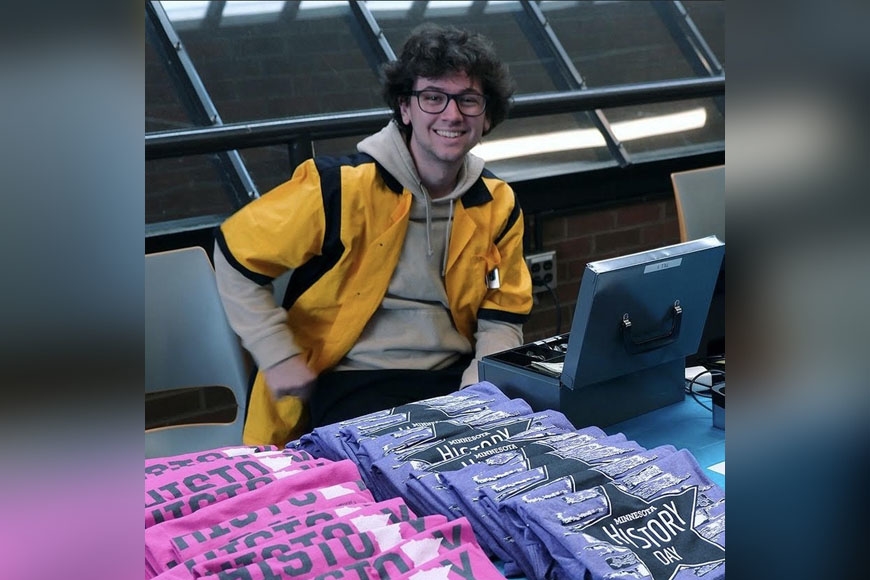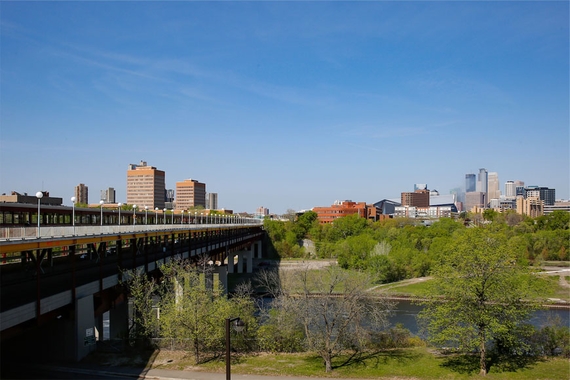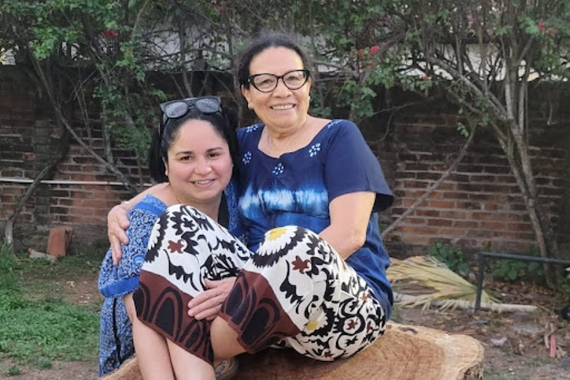Think Like a Historian
Having grown up in Dodgeville, a small town in southwest Wisconsin, attending a large, urban university would be a big change for Tyler Bradley. After touring universities as a prospective student, however, Bradley knew the University of Minnesota felt right; the campus felt “new and refreshing,” but most of all, the myriad opportunities presented by attending college in the Twin Cities stood out to him. Approaching his third year, Bradley is double majoring in history and economics and has already tapped into one unique opportunity available to undergraduate students: a mentor role in Minnesota History Day.
History and economics appealed to Bradley in the way that they offer varied and nuanced perspectives for seeing the world and life differently. He discovered a natural interest in critically thinking about both the past and present while being challenged by impactful teachers in high school, and he continues to foster those skills today.
History Can Be Personal
For Bradley, history can be personal. “Most historians will have a family member who was a storyteller,” he says. His connection to family storytelling started with his late grandfather, who told Bradley about life as a young man and reflected on times past. These conversations presented a way to not only learn from his great-grandfather, but connect with him. Economics presented yet another way to think about the world in addition to being enjoyable in his liberal arts education requirement courses.
Bradley continues to find ways to engage with critical thinking, history, and perspective, beyond his coursework. Last fall, Bradley set out to the University Fall Activities Fair in the Coffman Memorial Union to get involved. He explored the many options available, seeking something in line with his major and interests. There he met Postdoctoral Associate Andre Deckrow and Graduate Assistant Jake Henke.
Deckrow and Henke introduced Bradley to Minnesota History Day, a co-curricular program organized by the Minnesota Historical Society that connects middle and high school students with undergraduate mentors to explore topics in history. It was unlike anything he had heard of, and he jumped at the opportunity to apply historical thought while also getting the “chance to have some community engagement.” Today, he has completed two full years of mentorship.
Stewarding History
Alumni reflect on their experiences as undergraduate mentors for Minnesota History Day
Alumni Maddie Love (BA ‘19, political science) and Alex Medina (BA ‘18, history) look back on their experiences as undergraduate mentors for Minnesota History Day, and how those experiences shaped their career paths.
Finding Connections
Bradley spent his first year working with seventh graders at Sanford Middle School in South Minneapolis. Most recently, he returned to working with Sanford in addition to working with Anthony Middle School. What has delighted and surprised Bradley most out of this experience, he says, are the connections — connections with peers, with growth opportunities, and with his students and their teachers.
While one does not have to major in history to be a history day mentor, the role tends to attract history majors as well as other similarly-minded students and people. For Bradley, History Day has provided a way to meet fellow history majors and develop friendships with others in the degree program.
In addition to peer connections, Bradley has found that History Day presents a variety of opportunities to meet with people involved in the Minnesota Historical Society as well as other historical experts. While enrolled in mandatory training seminars for History Day mentors, Bradley learned from a variety of knowledgeable speakers all with history backgrounds, including a curator for the Mill City Museum. In addition to connecting students with professionals, students learn about internships and other career-building opportunities which Bradley plans on making the most of.
Students at the Core of the Program
History Day wouldn’t be complete without connecting with the middle and high school students at the heart of the program. As a mentor, Bradley emphasizes, it is key to help students through the critical thinking process in their projects as well as to celebrate students where they are at. Simply completing a History Day project, he says, is something that a student can feel proud of, regardless of their academic background.
“Middle school in general is a really interesting age,” Bradley observes, noting that his students are “just trying to figure themselves out” as they progress from elementary school to high school mindsets. You’re guaranteed to have a classroom full of energy—“most of the time,” he says—and while students aren’t always locked into the activities, when you can find a way to match the work and the energy, it “means it’ll be something new and fun” in the classroom.
What It Means to Be a mentor
Being a History Day mentor also means being an example to younger students. Working with college students as middle or high schoolers makes college seem like a more accessible goal; it shows students that “if you work hard, if you’re intentional about what you’re doing, you can go to college too,” Bradley explains. Being that example and working with students to engage in history in a new way has been an important element of the experience for Bradley.
Lasting impacts of the program emerge in how students learn to think, both academically and in regards to their own work. “They learn to think in a historical way, as a historian would,” Bradley says; they are guided by the course design to think about cause and effect as well as change and continuity over time. Their projects encourage nuance, and the best lessons show that “things are not black and white in everyday life,” so “why do we expect them to be black/white in history?” As students develop these critical thinking skills, they learn about themselves as students too. Projects may not be fun sometimes, but it is an important experience for a student to be “able to look back on a History Day project, and say I did that.”
In Bradely’s mentorship experience, he has focused on supporting students as they start their research projects, finding sources and synthesizing ideas. While breaks and university schedules can pose obstacles for spending time with his students, Bradley aims to find ways to make it work and support them throughout the process from the beginning of the school year all the way through competition season in March and April.
The Many Takeaways of History Day
Mentoring has shed a new light on Bradley’s understanding of educational pedagogy and how students are taught history. “It’s really the transition between elementary and middle school,” Bradley says, where students shift from being “given the facts” to asking larger questions and making historical arguments. In beginning to think critically, students stretch beyond the basics of a situation and delve deeper into the impacts.
Students participating in History Day “learn that history isn’t just going to a lecture where your teacher throws out a bunch of boring facts” it’s “bigger meanings and lessons,” something that can inform a “philosophy about how to live life.” This is an educational experience that sticks with students, just Bradley learned in his high school introduction to historical critical thinking.
While Bradley doesn’t plan on becoming a teacher, he does hope to continue engaging in critical thinking and community impacts with plans to potentially pursue a Masters of Public Administration or attend law school. He isn’t quite sure, but he still has time to explore and learn more about his path ahead. While many student mentors involved in History Day tend to pursue careers in education after graduation, Bradley reflects that it is a flexible program with many opportunities to make the most of your time with it.
Why I Give to History Day
“History comes alive when we connect our own experiences with those who came before us. How excited we were as first graders to take a field trip from Minneapolis to St Paul. Words like ‘Twin Cities’ began to make sense as we crossed over the Mississippi River bridge in our school bus. Houses, cars, and schools all looked similar to our own until we saw the barn.
We arrived at the St. Paul campus of U of M to see real farm animals like the ones we had been reading about in class. We saw where they lived, what they ate and how they were taken care of. My interest in history began that day as a first grade student from Fuller Elementary School in Minneapolis and continues to this very day.” – Mary Benson
This story was written and edited by Cass Bryant, undergraduate student.



